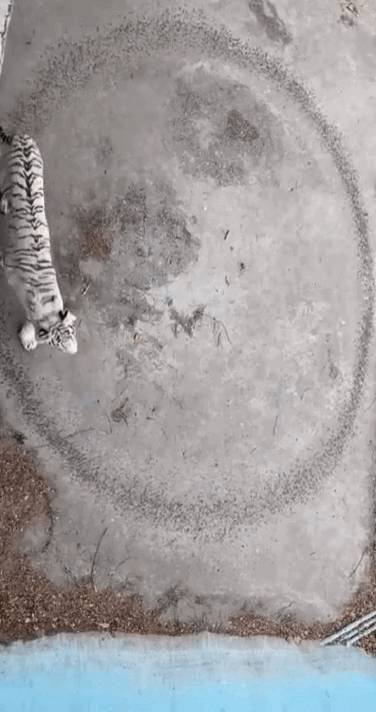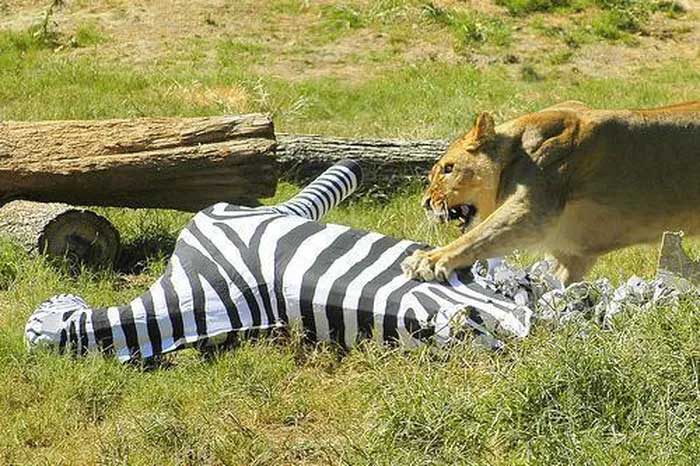Is Depression Exclusive to Humans? Absolutely Not! Many Captive Animals Also Suffer from “Depression.”
Depression is a type of emotional disorder that can lead to prolonged feelings of sadness and loss of interest, and it can even result in actions that threaten the life of the individual or those around them.
However, it is not only humans who experience depression; animals do as well. Yet, they typically do not suffer from this condition in the wild; it is often a result of human captivity.
Recently, a video filmed in a tiger enclosure at the Beijing Zoo raised concerns among netizens. In the video, a Bengal white tiger was seen continuously walking in circles within a small outdoor exercise area. Its paw prints formed a circle in the ground, indicating a state of “stereotypic behavior.”

The Bengal tiger walking in circles unconsciously in a cramped enclosure.
For zoo animals, the transition from a wild environment to captivity can undoubtedly lead to discomfort. In zoos, especially in medium and small cities, if we observe closely, we can often witness such scenes. Some animals may move along a fixed path, pacing back and forth, standing still and shaking their heads, or even walking in circles in place.
You may think this is a normal phenomenon following captivity, but in reality, this is a manifestation of illness. Like the Bengal tiger at the Beijing Zoo, this behavior is technically referred to as “stereotypic behavior.”
The main characteristic of wild animals is their inherent “wild” and “natural” instincts, or their ability to adapt to their environment and live without constraints. However, when they transition from the wild to a human-created captive space, they are restricted in space and their living habits change. If they cannot adapt, some animals will exhibit unusual “stereotypic behaviors,” which are repetitive actions that essentially serve no specific functional purpose.
Studies have shown that stereotypic behaviors can be categorized into three types: repetitive mouth movements, repetitive movements along the same path, and high-frequency monotonous behaviors. For example, captive elephants often sway their heads back and forth, captive tigers frequently walk in circles, and crustaceans may float on the water’s surface or bang their bodies against glass walls or swim in circles in their tanks…
According to Wang Song, a researcher at the Institute of Zoology under the Chinese Academy of Sciences and an animal protection expert, there is still some debate from an academic perspective regarding the causes of stereotypic behaviors in animals. However, it is generally accepted that these behaviors may stem from limited living space, low environmental diversity, disturbances from artificial environments, and the destruction of the animals’ natural habitats.
“Especially in a monotonous and restricted captive environment, stereotypic behaviors are more likely to occur, with bears being the most evident,” Wang Song said.
Taking brown bears as an example, in the wild, most have territories ranging from 700 to 1,000 square kilometers, while some may have smaller areas of about 20 to 40 square kilometers. However, the range of movement for brown bears in zoos is typically limited to just a few hundred square meters, which is incomparable to their natural environment.
As a result, in zoos, we often see bears walking in circles, licking their paws, or standing on two legs waiting for food.

Another stereotypic behavior of tigers is incessantly shaking their heads.
Even giant pandas, the symbols of zoos in China, are not exempt from involuntary stereotypic behaviors. For instance, a giant panda named Shulan has a habit of chewing on fake objects, playing with its tongue, and creating a lot of white foam at the corners of its mouth. Another giant panda, Xianxian, at the Shandong Dezhou Zoo, has a habit of shaking its head and sticking out its tongue continuously. All of these are typical stereotypic behaviors.
Zheng Yu, the director of the wildlife project at the World Animal Protection Association, believes that stereotypic behaviors are psychological issues caused by the significant stress animals endure and are unable to resolve on their own. These behaviors lead to behavioral problems and potentially unmanageable consequences.
In fact, it is not only zoo animals that exhibit stereotypic behaviors; even household pets and preschool children can display such behaviors due to environmental issues. For example, when external conditions change significantly, or when living spaces are too cramped, cats may excessively groom themselves, while preschool children who are often confined alone in a room may develop habits of fidgeting, sucking their thumbs, and similar behaviors.

Feeding wild animals and birds of prey with whole carcasses or packaging food in boxes can take them longer to consume than if they were to swallow pieces of meat, which would require them to expend more energy and leave them with less idle time.
Fortunately, stereotypic behaviors are not an irreversible phenomenon. In recent years, more and more zoos have begun to recognize the detrimental effects of stereotypic behaviors on animals. Care staff have started to employ various methods to improve the quality of life and living conditions for captive animals.
Additionally, some animals have unique living habits, such as patrolling their territories, so it is essential to distinguish clearly between stereotypic behaviors and normal biological behaviors to avoid over-interpretation.
In terms of changing environments to prevent stereotypic behaviors, the most crucial factor is enriching the captive environment. Simply put, this means enhancing the environment, increasing the simulation of natural conditions, and adding complexity to the surroundings. This approach stimulates the animals’ senses, enriches the captive environment, and ultimately aims to recreate the ecological appearance of animals in the wild.
At the end of October last year, the Beijing Zoo in China established a new captive system. These enclosures, spanning over 500 square meters, maximally simulate various ecological environments such as forests, deserts, polar tundras, and tropical rainforests. Additionally, they set up 11 outdoor sports fields to meet the diverse needs of different species, allowing them to exercise and hunt, thus eliminating periods of boredom.

Do not confine animals in cramped, outdated, and empty enclosures.
Of course, enriching the environment needs to be carefully planned, especially regarding the safety and health of the animals. The types of paints used may be toxic, and materials like ropes, nets, and rubber bands can entangle and even harm young animals. Generally, this also requires the wisdom and meticulousness of professionals.
Moreover, a higher level of environmental enrichment is creating large-scale simulated environments. These are places where various wild animals are kept in a space that mimics their original habitat, and visitors can still explore and experience the animal world. This not only brings humans closer to animal species but also provides a tangible experience of natural environments for the animals.
Osaka Aquarium in Japan is one of the exemplary models of this type, allowing animals to live in environments similar to their natural habitats while ensuring economic potential by attracting large numbers of visitors.

Japan’s Osaka Aquarium, with its “immersive design,” is considered a model in the field of animal care.

















































